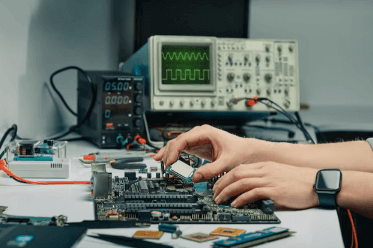Question
s1 = - 0.000245 x 10⁹ rad/sec.
s2 = - 0.0748 x 10⁹ rad/sec.
s3 = - 0.670 x 10⁹ rad/sec.
s4 = - 4.38 x 10⁹ rad/sec.
The upper 3 dB frequency of the amplifier will be
a.
s1
b.
s1 + s2 + s3 + s4
c.
s1 + s4
d.
s4
Posted under Electronics and Communication Engineering
Interact with the Community - Share Your Thoughts
Uncertain About the Answer? Seek Clarification Here.
Understand the Explanation? Include it Here.
Q. A transistor amplifier has poles at s1 = - 0.000245 x 10⁹ rad/sec. s2 = - 0.0748 x 10⁹ rad/sec. s3 = - 0.670 x 10⁹ rad/sec. s4 = - 4.38 x 10⁹ rad/sec. The upper 3 dB...
Similar Questions
Explore Relevant Multiple Choice Questions (MCQs)
Q. An engineer designs an amplifier to have a voltage gain of 60, but when constructed it only had a gain of 50. What value of feedback will double the gain?
View solution
Q. The maximum theoretical efficiency for class A amplifier is
View solution
Q. Assertion (A): A class C amplifier can also be used as frequency multiplier
Reason (R): When narrow current pulses drive a resonant circuit the output can be a near perfect sine wave
View solution
Q. The parameter β of a BJT change by 300%. If self bias is used in the amplifier using this BJT, the quiescent value of IC and VCE remain almost the same.
View solution
Q. A bypass capacitor produces
View solution
Q. Rise time in a transistor is change from
View solution
Q. In a JFET, gates are always
View solution
Q. By connecting external resistances to a differential amplifier we can adjust
View solution
Q. A feedback network to be used with an amplifier to provide oscillation is tested and found to give an output of 0.124 V with a 0.5 V input. What must be the minimum gain of the oscillator to provide oscillations?
View solution
Q. CMRR is the ratio of differential voltage gain to common mode gain.
View solution
Q. The purpose of impedance matching in an amplifier circuit is to achieve
View solution
Q. In a BJT CE amplifier circuit the value of coupling capacitor should be such that
View solution
Q. In order to rectify sinusoidal signals of millivolt range (< 0.6 V)
View solution
Q. The common gate amplifier has a characteristically __________ input resistance and a __________ output resistance.
View solution
Q. For input and later stages, BI-FET op-amp use
View solution
Q. The emitter coupled pair of BJT's gives a linear transfer relation between the differential output voltage and the differential input voltage Vid only when the magnitude of Vid is less a times the thermal voltage, where α is
View solution
Q. In most transistor the collector region is made physically larger than the emitter region
View solution
Q. The leakage current in CB configuration may be around
View solution
Q. In a CE amplifier the Q point is very close to saturation point on the dc load line. This results in
View solution
Q. Class-B amplifier has less efficiency compared to
View solution
Recommended Subjects
Are you eager to expand your knowledge beyond Electronics and Communication Engineering? We've handpicked a range of related categories that you might find intriguing.
Click on the categories below to discover a wealth of MCQs and enrich your understanding of various subjects. Happy exploring!








